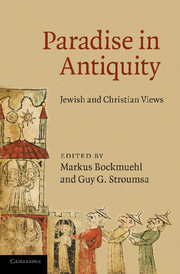Book contents
- Frontmatter
- Contents
- Notes on contributors
- 1 Introduction: the paradise chronotrope
- PART I PARADISES OF SECOND TEMPLE JUDAISM AND CHRISTIAN ORIGINS
- PART II CONTEMPORIZING PARADISE IN LATE ANTIQUITY
- 8 Tertullian's law of paradise (Adversus Judaeos 2): reflections on a shared motif in Jewish and Christian literature
- 9 The language of paradise: Hebrew or Syriac? Linguistic speculations and linguistic realities in late antiquity
- 10 The tree of life and the turning sword: Jewish biblical interpretation, symbols, and theological patterns and their Christian counterparts
- 11 Erotic Eden: a rabbinic nostalgia for paradise
- 12 Paradise for pagans? Augustine on Virgil, Cicero, and Plato
- 13 Heaven as a political theme in Augustine's City of God
- 14 Locating paradise
- 15 Epilogue: a heaven on earth
- Select bibliography
- Index of subjects
- Index of authors (cited in text)
- Index of sources
14 - Locating paradise
Published online by Cambridge University Press: 06 December 2010
- Frontmatter
- Contents
- Notes on contributors
- 1 Introduction: the paradise chronotrope
- PART I PARADISES OF SECOND TEMPLE JUDAISM AND CHRISTIAN ORIGINS
- PART II CONTEMPORIZING PARADISE IN LATE ANTIQUITY
- 8 Tertullian's law of paradise (Adversus Judaeos 2): reflections on a shared motif in Jewish and Christian literature
- 9 The language of paradise: Hebrew or Syriac? Linguistic speculations and linguistic realities in late antiquity
- 10 The tree of life and the turning sword: Jewish biblical interpretation, symbols, and theological patterns and their Christian counterparts
- 11 Erotic Eden: a rabbinic nostalgia for paradise
- 12 Paradise for pagans? Augustine on Virgil, Cicero, and Plato
- 13 Heaven as a political theme in Augustine's City of God
- 14 Locating paradise
- 15 Epilogue: a heaven on earth
- Select bibliography
- Index of subjects
- Index of authors (cited in text)
- Index of sources
Summary
COLUMBUS AND THE DECLINE OF PARADISE
In the pleasant early days of August 1498, Christopher Columbus (1451–1506) caught his first glimpse of the South American mainland. On turning from Trinidad, off Northeastern Venezuela, into the Gulf of Paria between the mountainous Venezuelan headland of Marabal and the island of Trinidad, he ran into a mass of fresh water from the mouth of the Orinoco River and was enraptured by the idyllic climate and sights of what faced him there. “Holy Scripture,” he famously recorded in his logbook,
testifies that Our Lord made the earthly Paradise in which he placed the Tree of Life. From it there flowed four main rivers: the Ganges in India, the Tigris and the Euphrates in Asia … and the Nile, which rises in Ethiopia and flows into the Sea at Alexandria … I do not hold that the earthly Paradise has the form of a rugged mountain, as it is shown in pictures, but that … by gradually approaching it one begins, while still at a great distance, to climb towards it … I do believe, however, that, distant though it is, these waters may flow from there to this place which I have reached… All this provides great evidence of the earthly Paradise, because the situation agrees with the beliefs of those holy and wise theologians and all the signs concord strongly with this idea.
- Type
- Chapter
- Information
- Paradise in AntiquityJewish and Christian Views, pp. 192 - 209Publisher: Cambridge University PressPrint publication year: 2010
- 3
- Cited by



